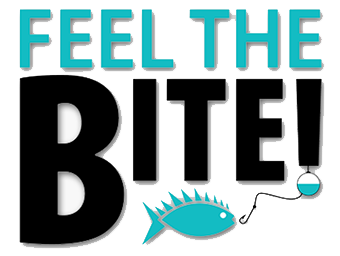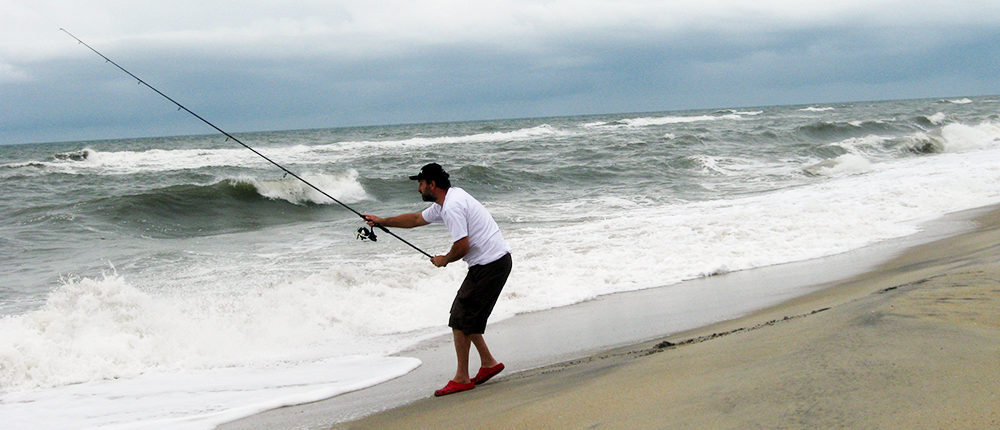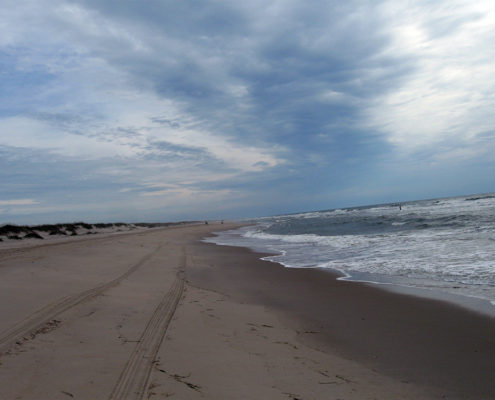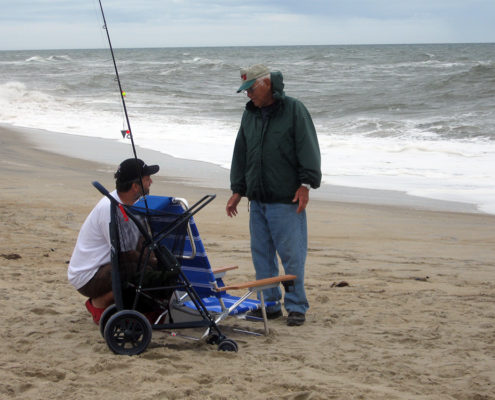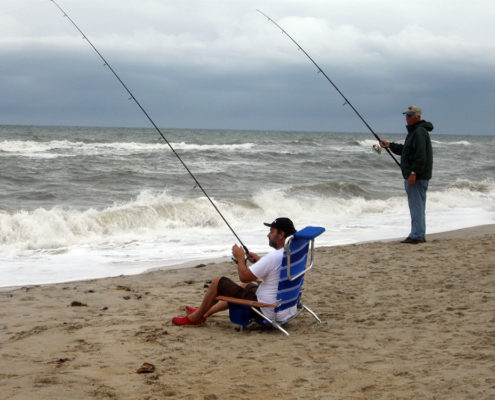Outer Banks North Carolina Stingray Close Encounter
Because of the long-distance casting involved with surf fishing and the tendency of rigs to be pushed along by currents, surf anglers generally spread out as much as 50 to 100 meters apart. With the noise of the surf, it means anglers communicate using hand signs only. Not much help to me as someone without sight, but I love it!
Rogue waves present a constant threat. Wading into the water is common to gain extra distance on casts, and to play fish without having to skid them up on to the beach to execute a release. It’s for this reason the year before I was turned down by several guides who were conducting a surf fishing program that included a mix of in-class and actual surf fishing. I was told that they didn’t have sufficient staff to keep me safe, since surf anglers are expected to watch out and execute a running retreat when rogue waves are detected. Failing to get out of the way can easily mean being knocked down and sucked into the ocean. I was disappointed to be told that I would not be allowed to participate in the surf fishing course, but it’s why I’m always up-front about my disability so there’s no surprises.
Surf fishing is a risk I’m willing to take and continue to do so. I might not see a rogue wave coming, but I’m pretty solid on my feet and a good swimmer. What I’m not always prepared for is what bites as the more you move south, the more fish have teeth and other potentially dangerous attributes.
The year prior I had met Herald, an angler from Pennsylvania that spends every October in the Outer Banks in North Carolina surf fishing. Herald introduced me to the sport, and was around the next year as well when I returned to the area for the second time to deliver the key note speech at the annual NC Visually Impaired Fishing Tournament (visit www.BlindFishingBoat.com for more about the NCVIP event).
Once again, the constant pounding of the waves on the beach and sand bars canceled out hearing anything other than the odd Seagull. I knew Herald would be close by (50-meters down from where I was standing), because he told me he would be. With the sound of the waves, I may as well have been stranded on some remote Pacific island – it’s amazing!
I knew you can catch just about anything in the sea and was expecting to tie into some of the Blue fish that are known to be moving through the area at the time, and which I caught plenty of the year before. I wasn’t disappointed with some decent 1-3lb Blues within fairly short order.
The waves were about 2-meters high and quite steep, which meant casting directly perpendicular to the wave fronts was crucial if I didn’t want the force of the breaking waves to drag my line sideways. (Waves breaking on your line above the water on an angle will push your line causing your bait to pendulum towards the shore.)
I was completely taken off guard when I hooked and pulled from the surf this next fish. I knew I had something fairly decent on the end of my line, but the strike was like nothing I had ever experienced before. One minute I was keeping tension on my line and the next the 5oz weight I was using lifted off the bottom and was moving parallel to the beach. I reeled up the slack and set the hook. Drag began peeling off my line instantly.
Herald witnessed my 12-foot (Carp) rod with a good bend in it and came over to offer support. After a good tussle with the fish, we were shocked when a Stingray emerged from the waves — yes, the same fish that killed Crocodile man. Within seconds it was 2-3 meters in front of our legs as we stood in a foot of water between waves.
Herald said he had never actually seen a Stingray caught before, but recognized it immediately. The question was what to do with it.
Stingrays possess only one highly poisonous stinger in their tail – once they use it its gone. Thus, they don’t just swim around willy-nilly stinging what ever they come across.
Maestro, my guide dog, was perfectly willing to personally chase the Stingray back into the sea, and actually managed to tare free of the sand stake he was tethered to, making a rush for the fish. He stopped in his tracks though with a yell from Herald and sharp command from me.
Normally I unhook all my own fish, but in this instance, I was more than happy to let Herald set this killer free to, once again, roam the sea. I had actually hooked the Ray in the wing, which explained the weightlessness sensation I experienced in my line just prior to setting the hook.
Herald found a scrap of drift wood to use to pin the Ray down while he disengaged the hook. He then used the same wood to shove the Ray back into the breakers. By the third wave, it was gone.
A big thanks again to Herald for his assistance on the beach. I hope our paths cross again.
